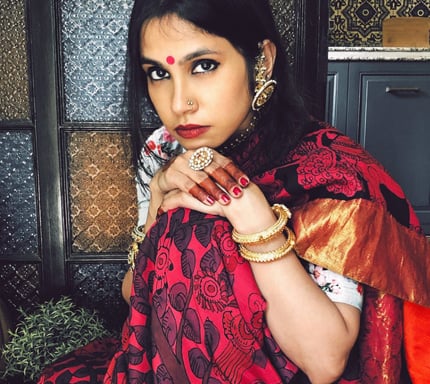Voice of Fashion Feature: Rakhwaali by Ayush Kejriwal | Trivium PR
– Sanhati Banerjee, TVOF
The designer’s Instagram campaign dresses up modern-day, multitasking women in a debatable interpretation of domestic goddesses
VOICE OF FASHION FEATURE: On May 27, designer Ayush Kejriwal launched the “Rakhwaali” campaign on Instagram in collaboration with production and communication agency Studio Gaaba. Due to restrictions induced by the coronavirus lockdown, the shoot was conducted virtually using FaceTime, the press release announces.
A Glasgow-based designer, Kejriwal has built his brand solely on Instagram and digital tools. He works with Indian weavers to create an array of handloom saris, from Banarasi and Katan to Patola and Kalamkari. With a growing following, he has gradually expanded into stitched garments and jewellery as well. He ships worldwide, taking orders on email and WhatsApp. Kejriwal is known for his distinct Instagram presence, where design stories are combined with social messaging for his 191k followers.
The term Rakhwaali in Hindi means “caretaker” or “guard”. “At times like this, while most of the communications revolve around the narrative of not having to burden women further, seldom do they talk about men or other family members sharing this labour,” states a concept note from Studio Gaaba. “However, we are starting to build up our awareness surrounding this subject, due to being confined at home as we are aware now of the amount of hard work that goes into daily household work. While taking care of the household chores, work-life is thrown into the mix as well, attending Zoom and Skype group calls while prepping meals and sweeping floors.”
A Fashion Campaign with a Message
In the slow and seductive build-up of the black-and-white campaign video, the camera pans the domestic space of the model—incidentally the designer’s sister, Ayushi Kejriwal. The Rakhwaali is seen in the kitchen, chopping fruits on the floor as she looks up, or sitting pensively with chin resting on gathered knees. A montage of close-ups of the model’s henna-dyed fingers decked up in a range of chunky silver jewellery from big rings or a stack of bangles and bracelets to heavy-set chokers, silk saris, bindi, kajal, long hair lead up to a shot where she holds a tray of glasses and teapot.
These stylistic markers place the protagonist at the heart of a traditional Indian household. But that’s not all—this is the narrative of a modern-day shero who juggles domestic duties with Zoom webinars and Skype calls; the same bejewelled hands that hold the tray transition on to the laptop keyboard.
The pre-existing range that offers hand-painted Kanjeevaram, Kalamkari, Patola and Chanderi silk saris are not new in Kejriwal’s fare; however, those featured in the campaign have been showcased for the first time. A fashion campaign aimed to create awareness about the amplified struggles of women during this period, it features a highly wearable range of silver jewellery and artistic weaves. However, it gets warped in mixed messaging around women’s rights and realities.
Revered by the Male Gaze
The eye of the stylist or that of the visual lens becomes the male gaze. But to understand it better one must pay attention to the voiceover narration—by Kejriwal himself—that hails the rakhwaali as the unsung hero of our times. In this narration, she is the “Pyari Gharwaali” or “beloved homemaker”; the custodian of “our” home, family, maan or honour and abhimaan or pride. In effect, it ends up situating the woman within a patriarchal framework.
The campaign places the rakhwaali among “mothers, sisters, wives, partners, girlfriends, aunties, grandmothers, house maids or anyone else who is selfless and committed to bring joy and happiness around them in these difficult times” or who work “tirelessly” or with “relentless devotion”.
The Debate
Yet, such terms complicate and mix up the discussion of gendered roles in domestic spaces, as domestic work remains unpaid and undervalued. Viewing domestic labour through the lens of romance and glamour confines it in the sexist trope.
In another video, the model says “sahi toh kaha Ayush ne” (Ayush is so right) about extending a helping hand to the woman of the house; if she is cooking, why can’t men clean up the dishes? This is not a question of charity or love—it is a question of equality and dignity.
The misplaced notion of respecting a rakhwaali stems from the urge to put women on a higher pedestal—the hotseat of a domestic goddess, expected to look beautiful and wear decorative Indian weaves while working like a superwoman.
In the press release, the designer says, “the idea is to humanise a message”. The phrase “Rakhwaali ke Rakhwaale” reaches the viewer through the voiceover in the video—why do women need a protector though?
Some of the captions in the campaign’s Instagram posts highlight how “instead of glorifying the women in our household as selfless heroes…we should be part of the struggle”. In a way, it does end up glorifying her; the protagonist is seen at her performative best with not a hair or pleat out of place. Don’t superwomen break a sweat?
click here to read more blogs
Photographs: Abhishek Golecha

